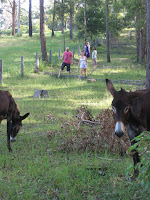 Well, it’s certainly been a month of contrasts!
Well, it’s certainly been a month of contrasts!The most obvious of these contrasts was experienced when I went from summer in Australia . . .
 . . . to winter in Minnesota.
. . . to winter in Minnesota.I’m not complaining, mind you. I had a wonderful sojourn in my homeland, but it’s good to be back in my other home, and involved in my work with both CPCSM and the Catholic Coalition for Church Reform. Plus, by all accounts, I missed the worst of the winter!

 Above: My hometown of Gunnedah in New South Wales, Australia - Saturday, February 6, 2010.
Above: My hometown of Gunnedah in New South Wales, Australia - Saturday, February 6, 2010.Right: With high school friends Lisa and Sue.
For more about my February 2010 visit to Gunnedah, click here.


Above and left: My friend Raph, with whom I spent a great day roving the mid-north coast on Tuesday, February 9, 2010.

Above: My nieces Sami and Layne at a special dinner to celebrate their birthdays.

Above: My parents, Gordon and Margaret Bayly - pictured at Port Macquarie’s Town Beach on St. Valentine’s Day.

 Above: At one of my favorite spots in Port Macquarie - a rock platform at the south end of Town Beach (and just below Swallows’ Ledge).
Above: At one of my favorite spots in Port Macquarie - a rock platform at the south end of Town Beach (and just below Swallows’ Ledge).This special place inspired two previous Wild Reed posts (see here and here).

Hey, nice ass!

Above and left: Toward the end of my time in Australia, my brother and his family bought two donkeys. I visited these gentle and friendly creatures on Sunday, February 14, 2010.

Above: Sami with one of the donkeys.

Above and below: My last night in Australia - Monday, February 15, 2010.
Pictured above (from left): my niece Sami, my sister-in-law Ros, Dad, Mum, my brother Tim, and my niece Layne.

 Above: With my younger brother and his family - Monday, February 15, 2010. (See also the previous Wild Reed post, The Bayly Family - January 2010.)
Above: With my younger brother and his family - Monday, February 15, 2010. (See also the previous Wild Reed post, The Bayly Family - January 2010.)Right and below: Farewell Australia . . .


. . . hello USA!


Above and left: My home in St. Paul, Minnesota.

Above: My snow-filled backyard!

 Above: Back at work!
Above: Back at work!On Monday, February 22, 2010, I attended the Minnesota House of Representative’s hearing on marriage equality.
For more about this event, see the previous Wild Reed posts Have Message, Will Be at Capitol and MN Legislators Hear from Supporters and Opponents of Marriage Equality.

Above: The thing I dislike most about winter in Minnesota: the treacherous ice!

Above and below: Minneapolis in winter.


Above: A sign of spring: open water on the Mississippi!
See also the previous Wild Reed posts:
Out and About - November 2009
Out and About - October 2009
Out and About - September 2009
Out and About - August 2009
Out and About - July 2009
Out and About - June 2009
Out and About - May 2009
Out and About - April 2009
Out and About - February-March 2009

















































